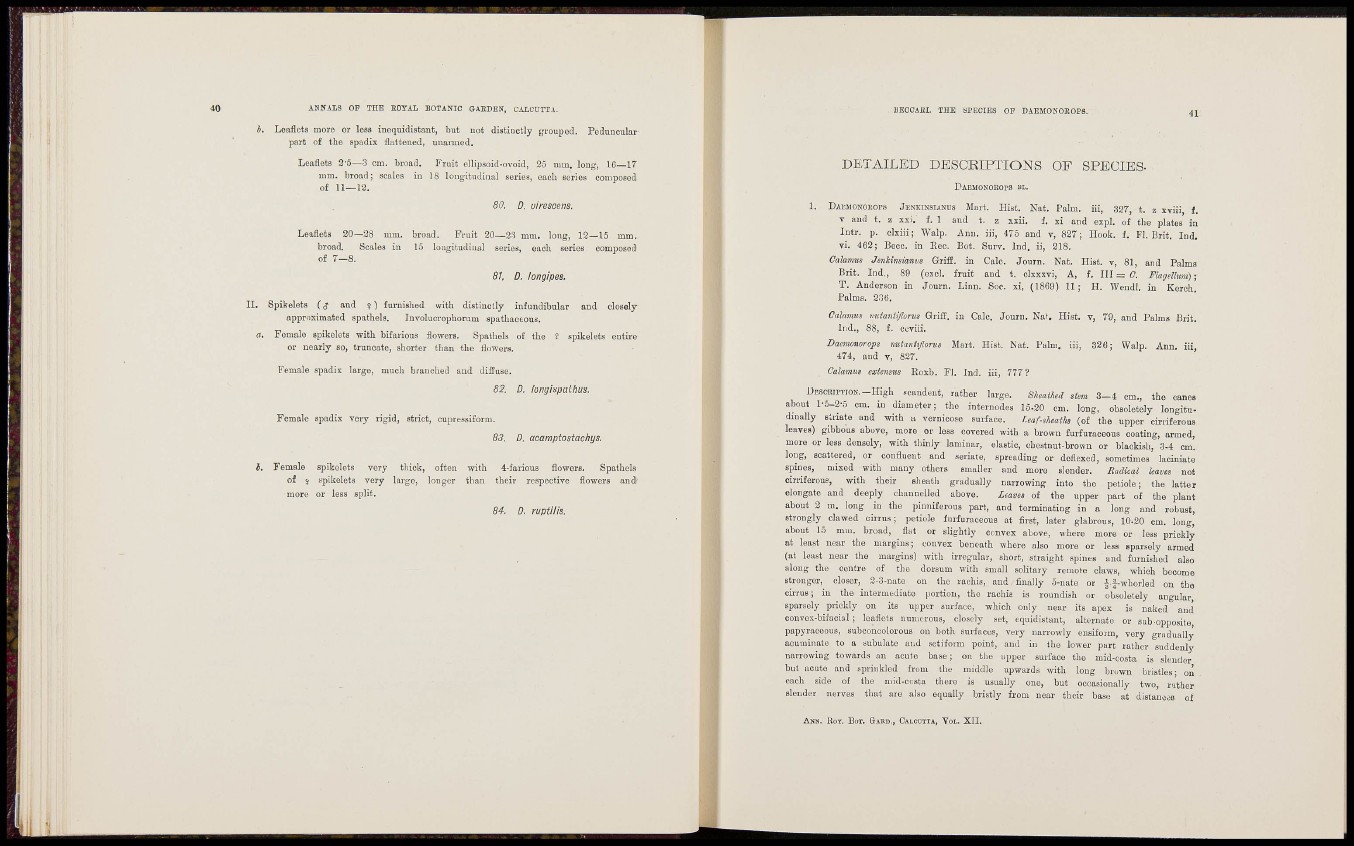
ANNALS OP THE BOYAL BOTANIC GARDEN, CALCUTTA.
b. Leaflets more or less inequidistant, but uot distinctly ^n-ouped. Peduncular
part of tlie spadix flattened, uuarmed.
Leaflets 2'5—3 cm. broad. Fruit ellipsoid-ovoid, 35 nm. long, 1.C 17
mm. broad; scales in 18 longitudinal series, each series composed
of 11—12.
80. D. uirescens.
Leaflets 20—28
broad. Scale
of 7 - 8 .
nm. broad. Fruit 20—23 mm. long, 12—15 mm.
in 15 longitudinal series, eacli series
81. D. longipes.
I I . Spikelets and s) furnished with distinctly infundibular and closely
apprnsimated spathels. Involuerophorum apathaceous.
a. Female spikelets with bifarious flowers. Spathels of the ? spikelets entii-e
or nearly so, truncate, shorter than the flowers.
Female spadis much branched and diffuse.
82. D. longispathus.
Female spadix very rigid, strict, cupressiforra.
83. D. acamptostaohys.
spikelets very tliick, often with 4-iariou8 flowers. Spathels
of ^ spikelets very large, longer than their respective flowers and'
more or less split.
84. D. ruptilis.
BECCABI. THE SPECIES OF DAEM0N0R0P8.
D F I T A I L E D D E S O K I P T I O N S 0 F S P E O I E S -
DAEMONOEOPS BL.
DAEMONOIÌOPS JEKKJKSIAHUS Mart. Hist. Nat. Palm, iii, 327, f,. Z sviii f.
T aijtl t. z xxi. t. 1 and t. z xsii. f. xi and expl. of the platea in
Inlr. p. ckiii ; Walp, Ami, iii, 47S and v, 827 ; Hook. f. FI. Brit. Ind.
vi. 462; Ecco, in Eec. Bot. Surv. Ind. ii, 218.
Caìamus Jenkimmnm Griä. in Cale. Journ. Nat. Hist. v, 81, and Palma
Brit. Ind., 89 (ojol. irnit and t. chxxyi, A, f. III = 0. fia<itüum) •
T. Anderson in Jonrn. Linn. Soc. si, (1869) 11 ; H. Wendl. in Kereh
Palms. 836.
Gaìamm vutmtißorm GriS. in Cale. Journ. Nat, Hist. v, 79, and Palms Brit.
Ind., 88, t. ccyiii.
nutanttfioms Mart. Hist. Nat. Palm, iii, 326; Walp. Ann. iii,
474, and T, 827.
Calamus cxtems Roxb. Fl. Ind. iii, 777?
DisoKlPTloii.-High seandent, rather large. Sheaited stem 3 - 4 em., the canes
about l'5-2-5 em. in diameter; the internodes 15-20 em. long, obsoletely longitudinally
Blriate and with a vernicose surface. Imf-shath (o£ the upper eiiriferous
leaves) gibbous above, more or less covered with a brown furfuraeeons coating, armed,
more or less densely, with tliinly laminar, elastic, chestnut-brown or blackisli, 3-4 em.
long, scattered, or conSuent and seriate, spreading or deSexed, sometimes laciniate
spines, njiied with many others smaller and more slender. Budital Imvii not
ciniferons, with their sheath gradually narrowing into the petiole; the latter
elongate and deeply channelled above. leavei of the upper part of the plant
about 2 m. long in the pinniferous part, and terminating in a long and robust,
strongly clawed cirrus; petiole fnrfnraceons at first, later glabrous, 10-20 cm. long,
about 15 mm. broad, fiat or slightly convex above, where more or less prickly
at least near the margins; convex beneath where also more or less sparsely armed
(at least near the margins) with irregular, short, straight .spines and fm-nished also
along the centre of the dorsum with small solitary remote claws, which become
stronger, closer, 2-3-nate on the rachis, and finally 5-nate or |.|-whorled on the
cuTus; in the intermediate portion, the rachis is roundish or obsoletely angular,
sparsely prickly on its upper surface, which only near its apex is naked and
convex-bifacial ; leafiets numerous, closely set, equidistant, alternate or sub-opposite,
papyraceous, subconcolorous on both surfaces, very narrowly ensiform, very gradually
acuminate to a subulate and setifoim point, and in the lower part rather suddenly
narrowing towards an acute base; on the upper surface the mid-costa is slender
but acute and sprinkled from the middle upwards with long brown bristles- on
each side of the mid-ccsta there is usually one, but occasionally two, rJthep
slender nerves that ate also equally bristly from near their base at distancea of
AKK. KOY. BOT. GARD., OAICDTTA, VOL. X I I .